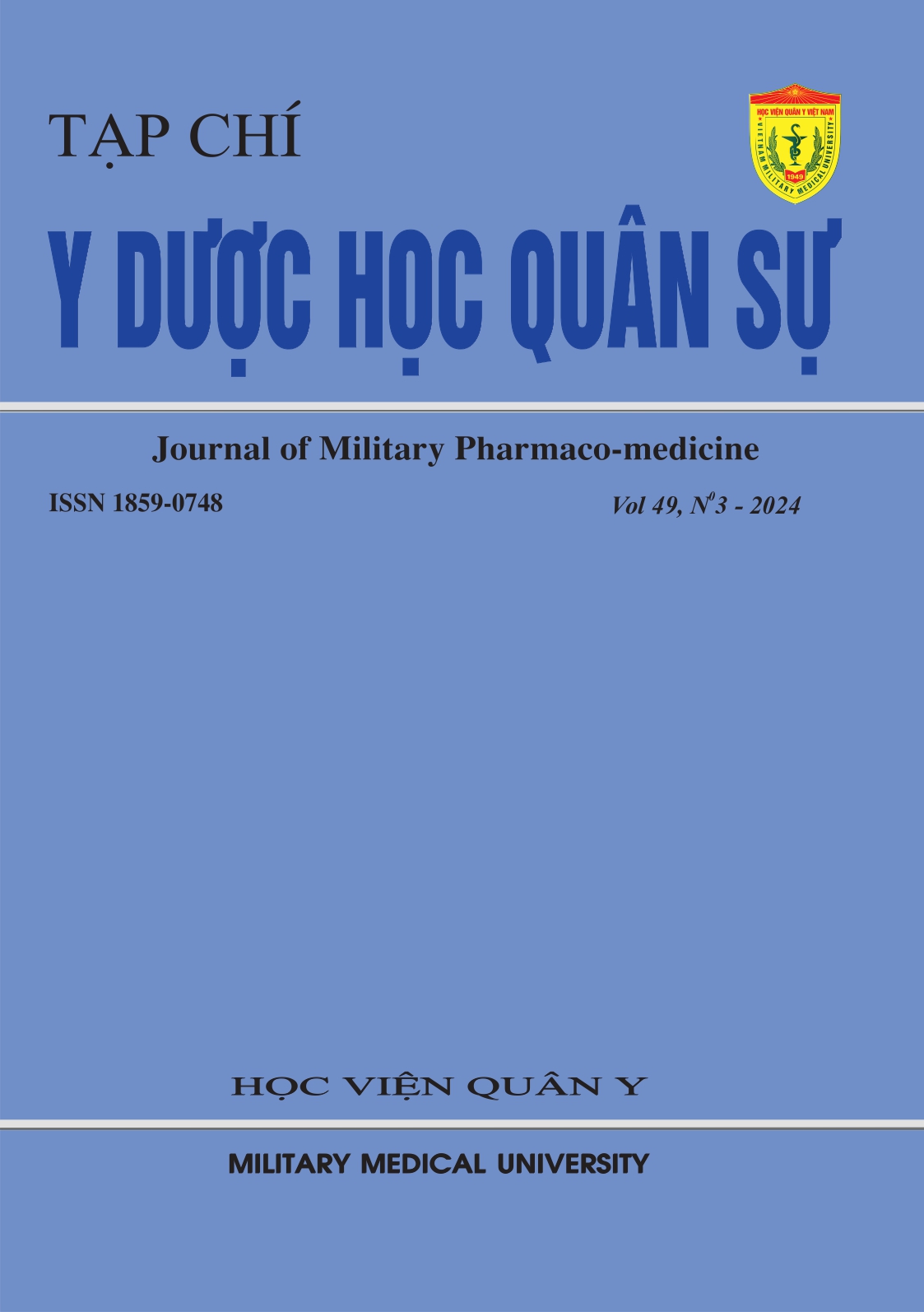ĐÁNH GIÁ KHẨU PHẦN ĂN VÀ MỐI LIÊN QUAN VỚI CHỈ SỐ BMI CỦA BỆNH NHÂN THẬN NHÂN TẠO CHU KỲ TẠI BỆNH VIỆN QUÂN Y 103
Main Article Content
Abstract
ASSESSMENT OF DIETARY AND FOOD HABITS OF END-STAGE RENAL DISEASE ON MAINTANANCE HEMODIALYSIS AT MILITARY HOSPITAL 103
Summary
Objectives: Survey on dietary intake and evaluate the relationship between body mass index and the level of energy and protein in the diet of end-stage renal disease on dialysis patients.
Subjects: 100 patients undergo maintanance hemodialysis at Military Hospital 103.
Method: cross-sectional study
Results:
The average dietary energy intake (DEI) of end-stage kidney patients on dialysis is 23.6(17.9-32.3) kcal/kg/day, lower than the level recommended by ESPEN. The average dietary protein intake (DPI) is 1.1(0.8-1.5) g/kg/day, below ESPEN's nutritional recommendations for end-stage kidney dialysis patients. The group of chronic kidney disease patients on dialysis with normal BMI accounts for the highest proportion (60%), followed by the overweight and obese group (29%) and the lowest is the group with chronic malnutrition (11%).
DPI (g/kg/24h) of female patients (1.2 (0.9-1.7)) was higher than male patients (1.1 (0.8-1.4)) with p <0.05. DPI (g/kg/24h) of patients with BMI<23 (1.2 (0.9-1.6)) is higher than that of patients with BMI>=23 (1.0 (0.7-1.2)).
Frequently consumed foods are: red meat (13.16 times), vegetables (12.16 times), poultry (2.87 times), and fruit (2.54 times). Less commonly used foods are: fish (1.47 times), eggs (1.33 times), milk (1.31 times), soybeans (0.68 times).
Patients with BMI≥23 had a lower odds of meeting the recommended DEI level (OR=0.123; p=0.047) and DPI level (OR=0.309; p=0.018) than the group with BMI<23.
Conclusions:
The diet of hemodialysis patients does not meet recommended levels of energy and protein. Foods that provide proteins with high biological value are not commonly used. End-stage kidney dialysis patients with high BMI are at risk of reducing their daily energy and protein intake compared to the recommendations.
Keywords: maintenance hemodialysis (MHD), End-stage Renal disease (ESRD), dietary, food habit.
Article Details
Keywords
Lọc máu chu kỳ, Bệnh thận mạn giai đoạn cuối, Khẩu phần ăn, Thói quen ăn uống
References
2. Nguyen TQ, TQ Vo, GH Luu, et al. Socioeconomic costs of chronic kidney disease: Evidence from southwest Vietnam. Journal of Clinical and Diagnostic Research. 2018.
3. Ikizler TA, JD Burrowes, LD Byham-Gray, et al. KDOQI clinical practice guideline for nutrition in CKD: 2020 Update. Am J Kidney Dis. 2020; 76(3):s1-s107.
4. Hoàng HV, TMH Đoàn, TTT Đặng và CS. Tình trạng dinh dưỡng của bệnh nhân chạy thận nhân tạo dưới 70 tuổi đang được quản lý tại Bệnh viện Đa khoa Hà Đông năm 2022. Tạp chí Dinh dưỡng và Thực phẩm. 2022; 18(3, 4):57-62.
5. Eknoyan G. Adolphe Quetelet (1796 - 1874) the average man and indices of obesity. Nephrol Dial Transplant. 2008; 23(1):47-51.
6. WHO. Appropriate body-mass index for Asian populations and its implications for policy and intervention strategies. Lancet. 2004; 363(9403): 157-163.
7. Fiaccadori E, A Sabatino, R Barazzoni, et al. ESPEN guideline on clinical nutrition in hospitalized patients with acute or chronic kidney disease. Clin Nutr. 2021; 40(4):1644-1668.
8. Kang SS, JW Chang, and Y Park. Nutritional status predicts 10-year mortality in patients with end-stage renal disease on hemodialysis. Nutrients. 2017; 9(4).
9. Zha Y and Q Qian. Protein nutrition and malnutrition in CKD and ESRD. Nutrients. 2017; 9(3).
10. Mahjoub F, R Mizouri, N Ben Amor, et al. Prevalence of malnutrition for elderly hemodialysis patients. Tunis Med. 2019; 97(4):588-594.
11. Ikizler TA, NJ Cano, H Franch, et al. Prevention and treatment of protein energy wasting in chronic kidney disease patients: A consensus statement by the International Society of Renal Nutrition and Metabolism. Kidney Int. 2013; 84(6):1096-1107.


